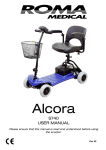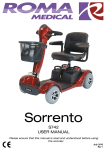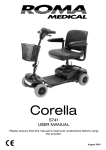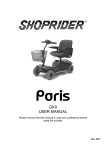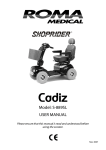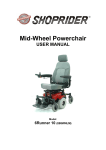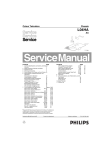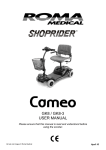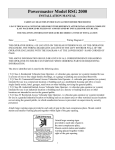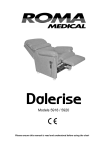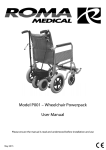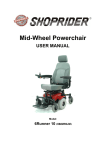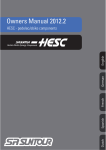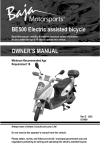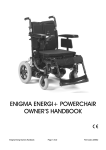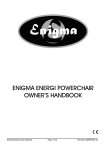Download User Manual
Transcript
‘Malaga’ Model No: 888WNLM USER MANUAL Please ensure this manual is read and understood before using the scooter. June 2011 Contents Page Introduction 2 Intended Use 2 Technical Specification 2 Feature Guide 3 Safety Advice 4 Adjustments Footrest Settings Arm Adjustments Seat Height & Back Angle 5 5 6 Controls 7- 8 Electro-magnetic Brake Release (Freewheel Operation) 8 Starting to Drive Getting started Moving off and steering Reversing Kerb climbing Reaching and stretching 9 9 9 9 10 Transport and Storage Dismantling Patient transfer 11 12 Batteries and Battery Charger 12 Maintenance 13 Troubleshooting 14 Further Information 15 1 INTRODUCTION Congratulations on your purchase of your Shoprider® power wheelchair. This model incorporates style and comfort with the latest in technological innovation. The powerchair is able to turn in the smallest of spaces indoors and outdoors due to it’s centre wheel drive layout. It is possible to climb kerbs of up to 5cm (2”). Direct drive twin motors and electromagnetic brakes give a safe and efficient drive. INTENDED USE This product was carefully designed for indoor or outdoor use in pedestrian areas by a single individual with limited mobility with a maximum weight of 115kg (18 st). It is not intended for road use. The intended user should possess the necessary physical, visual and cognitive skills to operate the powerchair safely. If you have any doubt, please consult your dealer/prescriber. It is important that the user reads and understands the safety advice given within this manual before attempting to operate the product to avoid possible injury to the user or bystanders and avoid damage to the powerchair or surrounding property. Note: Persons with lower body amputations should not use this device unless evaluated with artificial limbs fitted, as stability may be compromised due to an irregular centre of gravity. Technical Specifications Class 1 Medical Device Class B Indoor/Outdoor Vehicle Overall Size Length Width Height Battery Seat Dimensions Width Depth Height to floor Seat to lowest foot position 1050mm 600mm 1125mm 2 x 36Ah Maximum user weight Safe Working Slope 115kg / 18st 8º (14%) Weight with batteries Max. Speed Wheel Size Turning Radius 87kg / 191lbs 6km/h (4mph) 180/260/180mm 880mm 480mm 460mm 500-580mm 440mm Backrest height Range 500mm 26km (16m)* 4 amp 60mm Battery charger (off board) Ground Clearance *Passenger weight, ground conditions, condition can affect maximum range. 2 temperature and battery FEATURE GUIDE 1 7 2 3 6 4 1. 2. 3. 4. 5. 6. 7. 5 Adjustable height, width and angle armrests VSI Joystick controller Adjustable height, reclining seat Adjustable height and depth footplate 10” Centre drive wheels Lap belt Adjustable height headrest 3 SAFETY ADVICE DO: Read this manual carefully before using your powerchair Turn the controller off when transferring to and from the powerchair Select a slow speed when going down steep gradients of 8° (14%) or less Keep your feet on the footplate when you are moving. Never stand on the footplate. Ensure the seat is in a fixed position before driving Use the lap belt provided (read fitting instructions – page 16 & 17) Ensure the batteries are fully charged before your journey Avoid rough or soft terrain wherever possible Be aware of pedestrians and drive in a safe considerate manner Turn the power off when not in use Consult your doctor if you are unsure about your ability to use the powerchair Follow the maintenance guide to ensure safe operation of the powerchair DO NOT: Exceed inclines over 8º (14%). Anti Tippers must always be fitted. Traverse inclines or reverse down any inclines Attempt inclines if the surface is slippery Turn suddenly at high speed Switch off the power whilst the powerchair is still moving Use the powerchair where you cannot safely or legally walk Attempt to climb or descend kerbs over 5cm (2”) Attempt to negotiate steps or escalators Consume alcohol and drive or use a mobile phone whilst driving Travel through water or over soft terrain (mud, sand etc.) Sit in the powerchair whilst being transported in a vehicle Travel on the road other than to cross between pavements Use the powerchair in freewheel mode (electromagnetic brakes disengaged) Use any battery charger other than the recommended unit Carry passengers Attempt to lift the powerchair by the armrests or footrest Every care has been taken to ensure that your powerchair will give you safe, reliable service provided you adhere to the advice given above. 4 ADJUSTMENTS Footrest The footrest on the powerchair can be adjusted for height, depth and angle. To adjust the depth pull out the locking pin (1) and move to the required depth. Ensure the holes are aligned and replace the locking pin. To adjust the height pull out the locking pin (2) and slightly pull out the footplate. Relocate the mounting bracket into the desired slot and replace the locking pin. 1 2 Armrest Height The armrest can be set at four different heights. Simply undo the hand knob (1) and select the desired height. Ensure the holes align and re-fit the hand knob. 1 Armrest Width At the back of the seat there are two hand knobs (1). Undo a few turns and set the armrests at the required width. Re-tighten the hand knobs to secure the arms in place. Caution: DO NOT use the armrests to support the full weight of the occupant. 5 1 Continued….. Seat Height (We recommend that this operation be carried out by two persons) The seat can be set at three different heights. Rear View Firstly, ensure that the power is switched off and carefully unplug the joystick at the rear of the powerchair. Stand at the front of the powerchair and hold the seat while the second person releases the two yellow levers on the underside rear of the seat. Pivot the rear of the seat up to the front of the chair. Hold the chair in this position taking care not to let the seat rest on the joystick. Remove the locking pins to raise or lower the two rear seat support brackets to the required height and refit Release Levers the pins. Replace the seat. To adjust the front seat height remove the locking pin from the left hand support bracket. Support the seat and gently pull out the right side spring locking pin and adjust to the required height. Ensure the locking pins are fully re-engaged before operating the powerchair. Backrest angle Pull up on the backrest reclining lever (left hand side of the seat) and set the angle required by holding the backrest in the desired position and then release the lever, the backrest will stay in the position selected. The backrest can be lowered forward onto the seat for storage or transport. The backrest is spring-loaded and should be restrained from going forward when the lever is released. Note: The powerchair will become more unstable the further the backrest is reclined. Do not attempt to climb kerbs or slopes with the backrest in any reclined position. Do not carry bags on the back of the seat as they may affect stability. 6 Joystick Arm Control (VSI Controller) Battery Gauge (1) This is a 10-segment display, which indicates if the VSI is switched on and gives the state of charge of the battery. Also, any faults in your power chair’s electrical system are also indicated by this display. Refer to page 15 for details. Maximum Speed Indicator (2) This is a 5-segment display, which indicates the speed setting selected. 1 bar indicates the slowest setting and 5 bars the fastest. VSI Joystick On/Off Button (3) This button turns your joystick controller (VSI) on and off. Do not use this button to stop the power chair, except in an emergency. Horn Button (4) This button operates your powerchair’s horn. This should only be used to warn others of your presence and not as a rebuke of any form. Speed Decrease Button (5) This button decreases your maximum speed. Speed Increase Button (6) This button increases your maximum speed. Joystick (7) This controls the speed and direction of your powerchair. Push the joystick in the direction you want to go. The further you push it, the faster the speed will be. Releasing the joystick will automatically engage the brakes and bring the powerchair to a controlled stop. ‘Sleep’ Mode If the joystick is left on and the powerchair is not used for 10 minutes, it will go into ‘sleep’ mode, which is indicated by a slow flashing of the battery leds. Simply turn the power off and on to resume operation. 7 Continued….. VSI ‘Lock’ Function Your VSI controller is equipped with a lock function to prevent any unauthorised use. To lock the controller: When the power is on, press and hold the power button for about 1 second until the system bleeps. Move the joystick forward until it bleeps, then move it to the back position until you hear a bleep. Release the joystick – you should now hear a long bleep, this indicates the system is now locked. To unlock the controller: Press the power button until the speed indicator lights go from left to right. Move the joystick forward until it bleeps, then move it to the back position until you hear a bleep. Release the joystick – you should hear another bleep, this indicates that the system is unlocked and ready for use. Should the rubber boot/gaitor on the joystick become damaged, replace immediately. Brake Release / Freewheel Operation In the event of power failure or the need to move the powerchair without driving, the electromagnetic brakes can be disengaged by operating the two levers at the rear of the powerchair arrowed in the picture. Stand behind the powerchair and pull the levers toward you, this will then release the brakes allowing the powerchair to be pushed. Simply push the levers in to reengage the brakes. Release Levers Caution! Do not attempt to use your powerchair when not in gear. Freewheel mode should only be used in an emergency to manoeuvre the powerchair due to power failure or to move it WITHOUT AN OCCUPANT. Please ensure the brakes are re-applied as soon as possible after disengagement. 8 STARTING TO DRIVE YOUR POWER WHEELCHAIR Getting Started Select an area with plenty of space. Ensure that when seated in the in the powerchair you are in a comfortable position and can easily and freely operate the controls. Moving off and steering Turn the power on and check that your batteries are fully charged. Set your speed to a low setting. Gently push the joystick in the direction you wish to travel. The harder you push the joystick the faster you will travel. Release the joystick, this will automatically return to the centre position and the electromagnetic brake will be activated. Reversing Before reversing please ensure that the area behind is free from any hazard or obstruction. Kerb Climbing We recommend that wherever possible that a suitable access point such as a drop kerb or ramp be used. The necessity to climb a kerb directly should be as a last resort. Your Malaga powerchair is capable of climbing a 5cm (2”) kerb. Care should be taken when attempting to climb a kerb. Please address the kerb at 90º. Reduce speed to a slow rate until the front castor meets the edge of the kerb then push the joystick forward to accelerate up over the kerb. The backrest MUST be in the upright position before attempting any kerb/incline. Kerb Edge Warning: Do not hit the kerb at speed and do not attempt to climb a kerb if the anti tipping castors have been removed. Please take time to get accustomed to your new powerchair before driving in heavily pedestrianised areas or attempting to climb kerbs. You should always use a drop kerb or ramp if the seat is set in it’s highest position as the higher centre of gravity could cause the powerchair to become unstable. 9 Continued….. Kerb Descent We do not recommend that you descend a kerb (up to 5cm) in reverse or forward mode. Please use a ramp/drop-kerb in forward motion to descend. If a kerb descent is absolutely necessary in these circumstances an attendant must be present to aid the manoeuvre. Warning: NEVER reverse down a kerb or ramp onto a main thoroughfare. Reaching and Stretching Care must be taken when reaching and stretching for objects as this may affect the stability of the powerchair. When attempting to reach for objects it is very important that the power is OFF. Do not attempt to reach for objects on the floor by leaning forward or reaching between your knees. Do not attempt to reach for high objects by moving to the front of the seat. Do not attempt to reach for objects behind you by leaning over the back of the seat. 10 Disassembly & Assembly Warning: We advise caution when disassembling and lifting items. You must ensure that the person undertaking the action is able to safely and correctly handle the weight to avoid any personal injury. Ensure that the power is switched off and the joystick is dis-connected before dismantling. Method: Step 1: Remove the seat assembly by folding it forward as mentioned previously. Undo the two hand knobs just under the front of the seat, the seat should now freely lift from the chassis. You can remove the armrests to make the seat easier to handle. Step 2: Remove the footplate by removing the locking pin and simply pulling the footplate away from the frame. Step 3: Remove the four seat support brackets after removing the locking pins. Step 4: Remove the shroud by gently lifting it away from the retaining Velcro. Step 5: There are two locking pins situated at the bottom of the frame behind the centre drive wheels. Undo the security loop on the pin and remove the pins. The front chassis will now be able to be lifted away from the rear part. Locking Pins Step 6: Unplug the batteries and remove them from the rear chassis. Take care when lifting the batteries as they are heavy. (26kg each) Assembly is the reverse of the above procedure. 11 Storage and Use We recommend that your powerchair is stored in a dry environment, preferably covered and away from extremes of temperature and humidity. Avoid using the powerchair in rain or snow wherever possible and avoid leaving the powerchair in damp environments such as shower/bath rooms for prolonged periods of time. Patient Transfer Assistance maybe required depending on the limitations of the user. The powerchair must be turned off before transferring in or out of it. Place the footplate in the up position to enable the user to place their feet firmly on the floor and rise up from the seat. (Never stand on the footplate, as this will cause the powerchair to become unstable.) The armrest should only be used as a support and not a lever to transfer from the powerchair. To make a side transfer flip the armrest back out of the way and slide off the seat. In all these movements please seek assistance. Batteries and Battery Charger Batteries The powerchair is supplied with two maintenance free, sealed lead acid AGM batteries. These are fitted under the seat on the scooter. Battery performance can be affected by low temperatures, rough terrain and the weight of the user. Your battery gauge is a guide only on the level of charge remaining in the batteries. An active user can use 30% of the battery capacity or more per day. An inactive user may only use 50% of the battery capacity in a week. Battery Charger Charge the batteries completely (8-12 hours) prior to first use. Batteries supplied with your powerchair are specially designed for use on powerchairs and scooters and require an automatic battery charger. These chargers have an electronic switch that terminates the charge when the batteries are full. The battery charger is an 4-amp switch mode type off board. The charger is able to read the level of charge in the batteries and will switch off when the batteries are fully charged. To charge the batteries connect the plug lead into the charging socket on the front underside of the VSI joystick controller and the 3-pin plug into the wall socket and switch on. The battery charger has two lights. A constant red light will show when the battery charger is connected (this will flash if there is a break in the connection). The orange light indicates that the batteries are receiving charge, this will change to green when the charging cycle is complete. 12 Continued….. Caution: Always charge the batteries in a well-ventilated indoor area. You must still maintain charging the batteries even if the scooter is not to be used for a prolonged period of time (2 to 3 weeks). Failure to do so could result in permanent damage and render the batteries unusable. Wherever possible do not interrupt the charge cycle until the batteries are fully charged. Continual interruption can permanently damage the batteries. If the charging lead should become damaged discontinue use immediately and seek a replacement from your dealer. Disposing and recycling of used batteries Batteries must always be recycled correctly. Do not dispose of them with your domestic refuse. For further information regarding your nearest recycling facility please contact your local authority. MAINTENANCE Cleaning the Powerchair When cleaning the vehicle please pay attention to the following points: Only use a damp cloth and gentle detergent. Do not use any abrasive products. Do not use a hose or pressure washing equipment. Avoid water contact with any electrical components. Note: We advise the above method to prevent any damage to your powerchair, which could lead to any malfunction. Check / Charge Batteries Check removable parts are secure Check electrical connections are secure Check tyre pressures (Max. 25 psi) Check tyre wear (2mm minimum tread depth) Lubricate wheel / castor bearings with a light oil Complete inspection by an authorised Dealer 13 Annually Monthly Daily S-888 Range Maintenance and Inspection Weekly Routine Maintenance We recommend that the following checks be carried out on a periodical basis by a qualified person: Product Life Expectancy Your powerchair has been designed to provide the user with a long, reliable life provided it is correctly maintained and regularly serviced by an authorised dealer. However due to inevitable wear and tear and technological improvements it is recommended that the average usable life of this powerchair is five years. Note: Should any parts need replacing during routine maintenance please consult your local Dealer for approved spare parts for your powerchair. Failure to do so may damage the product and void your warranty. TROUBLESHOOTING Circuit Breaker Your powerchair is fitted with electronic controls that are programmed to protect the electrical system from overload. Fitted for extra protection is a circuit breaker. Should there be a situation where your powerchair stops for no apparent reason please check that the circuit breaker has not tripped. The circuit breaker is located at the rear of the powerchair. Note: Should the breaker continue to trip turn off the powerchair immediately and consult your dealer. Fuses Inline fuses to the batteries protect any overload in the circuit (70A blade type fuses situated under the shroud on the main battery cable). Note: Should the fuses need replacing please contact your local Dealer to ensure the correct sizes are fitted. Failure to do so could result in permanent damage to the powerchair’s electrics and possibly cause a fire hazard. Failure to do this will void your warranty. Check List If your powerchair fails to operate, please check the following: Unit is switched on Battery level indicator shows full charge Freewheel levers are in drive position Plugs and terminals are secure If the freewheel device has been operated with the powerchair switched on, it will not operate until the unit is switched off and on again. 14 VSI Error Codes Your VSI controller has the ability to diagnose possible errors in the electrical system, which may prevent your powerchair from operating. These are displayed on the battery gauge. The fault is shown against the number of lights flashing on the display. Battery Gauge 10 bars flash 9 bars flash 8 bars flash 7 bars flash 6 bars flash 5 bars flash 4 bars flash 3 bars flash 2 bars flash 1 bar flashing Possible Fault Battery voltage too high. Check battery connections. Electromagnetic brake fault Possible joystick controller fault Possible joystick fault Battery charger connected Right hand motor wiring fault Right hand motor disconnected Left hand motor wiring fault Left hand motor disconnected Low battery voltage Note: If your powerchair fails to operate after checking the above possible faults consult your local Dealer immediately. Also ensure that the VSI has not been accidentally locked or is in ‘sleep’ mode. Further Information Safety Information Regarding Electromagnetic Interference (EMI) Scooters and powerchairs are designed to operate under certain conditions. However, radio waves or electromagnetic fields may affect the operation of the scooter. The source of EMI could be radio or television transmitters or portable devices such as mobile phones, portable CB radios etc. Should any unintentional movement occur turn the scooter off as soon as safely possible. Solar Energy During periods of sunny weather, it is possible that surfaces of your powerchair may reach high temperatures (as with motor vehicles). Please take precautions if leaving the powerchair in direct sunlight for any period of time. Seek shade or cover the seat and hand controls to keep any temperature increases to a minimum. Health Factors Suitability for this product has been assessed on the user’s current state of health. It is essential that the user regularly monitor their ability to use the scooter safely. Please read and adhere to the guidelines set out in this manual. 15 Continued….. General Use Take heed of the information given in this manual regarding safety and the maintenance of your powerchair. If adhered to, your powerchair should give you years of reliable mobility. Storage and General Care We recommend that the powerchair is always stored in a dry environment away from damp, preferably in the home to protect the chassis and other components from corrosion or water damage. Do not leave the powerchair outside during rainstorms. If the scooter is wet, wipe with a dry cloth to ensure there is no ingress of water into the internal components of the powerchair (If the powerchair needs to be cleaned, use a mild detergent and warm water with a damp sponge or cloth. DO NOT throw water over the powerchair). Product Stability Scooters and powered wheelchairs are designed to allow the user flexibility of movement in restricted areas. Driving at maximum speed and attempting sharp turns can create a situation where the product becomes unstable. Therefore it is essential that the user pay attention the guidance set out in this manual. For maximum stability the speed setting should be set up to 50% of the maximum available (halfway between the tortoise and the hare or just entering the red sector on the speed indicator depending on the model. The main factors affecting stability are: Maximum speed setting Seat height User movement User’s manoeuvres Gradients or slopes Please keep your speed to a level where you can safely stop without having to make any erratic turns. Do not load bags etc. on the back of the seat as this will affect the centre of gravity and could increase instability. Do not lean outside of the ‘footprint’ of the product, especially whilst moving. Avoid making turns on gradients or slopes. Lap Belt Adjustment Your lap belt is a standard feature on your wheelchair which has been factory fitted. Your dealer should demonstrate how the lap belt should be adjusted. The purpose of the lap belt is to ensure that the user is seated in their most comfortable, safe position. 16 Continued….. Adjustment of your lap belt Ensure that you are sitting back fully into the seat with the pelvis as upright as possible and not leaning to one side. Close the buckle and position the belt so that the hip bones can be felt above the lap belt. Adjust the strap length by pulling on the open end of the belt. As a guide, the belt should be adjusted so that there is sufficient room for two fingers to slide between your body and the belt. Warning: Should any damage occur to the lapbelt, please replace immediately. The user should transfer to a bespoke vehicle seat whilst being transported. DO NOT sit in the powerchair whilst in any moving vehicle. Driving in Pedestrian Areas When using the scooter in pedestrian areas always lower your maximum speed to that of the pedestrians around you. Remember the stopping distance of your powerchair and always allow enough space to stop safely to avoid collisions with pedestrians or other objects. 17 Notes 18 Warranty Terms and Conditions This is to certify that your Shoprider product is warranted for a period of 12 months from the date of original purchase. This warranty is not transferable. Should a defect or operating fault arise within this period the Dealer from where the product was originally purchased should be notified immediately. Failure to register the fault may invalidate the warranty. The Dealer from where the product was purchased is responsible for any warranty repairs. If a fault occurs within this period due to faulty workmanship or materials that the product will be repaired (or replaced at the Companys discretion) free of charge. Any unauthorised modifications will invalidate the warranty. Parts which are subjected to normal wear and tear, accidental damage, neglect or misuse are excluded from this warranty. Normal wear and tear includes tyres, chassis covers, bulbs, seat coverings etc. Component parts replaced outside this period carry a six-month warranty. (Standard terms and conditions apply for this period). Model: Serial No: Purchase Date: Dealer Stamp Distributed by:Roma Medical Aids Ltds York Road, Bridgend Industrial Estate, Bridgend CF31 3TB Tel: 01656 674488 Fax: 01656 674499 Email: [email protected] www.romamedical.co.uk Shoprider reserve the right to change specifications without prior notice Manufactured by: Phisiang Machinery MFG. CO. LTD No. 108 Hsin-He Rd, Hsin-Feng Hsiang, Hsinchu County, Taiwan




















